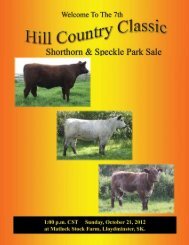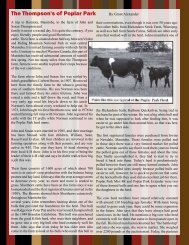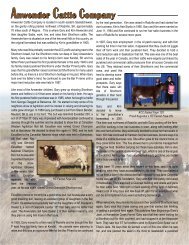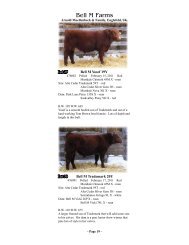Herbourne Shorthorns - Canadian Shorthorn Association
Herbourne Shorthorns - Canadian Shorthorn Association
Herbourne Shorthorns - Canadian Shorthorn Association
- No tags were found...
Create successful ePaper yourself
Turn your PDF publications into a flip-book with our unique Google optimized e-Paper software.
<strong>Herbourne</strong> <strong><strong>Shorthorn</strong>s</strong> - The Acheson Family<br />
By Grant Alexander<br />
If you ask<br />
Bill Acheson<br />
why he raises<br />
<strong><strong>Shorthorn</strong>s</strong>,<br />
he would<br />
say that<br />
<strong><strong>Shorthorn</strong>s</strong><br />
are the only<br />
breed of<br />
cattle that<br />
have been on<br />
the Acheson<br />
farm since it<br />
was settled<br />
in 1900 by his grandfather Dudley Easton Acheson.<br />
He is, in fact the third generation to raise <strong><strong>Shorthorn</strong>s</strong><br />
on this farm located near the town of Somerset, MB.<br />
His father, Herb Acheson was born in 1890 and lived<br />
at the farm until his death in 1975. During that time he<br />
raised a family of seven children on a quarter section<br />
of land, something that is hard for us to even imagine<br />
today. The <strong>Shorthorn</strong> herd was maintained at around 12<br />
cows and since all the calves were finished and sold by<br />
the pound, the Acheson’s always emphasized selection<br />
cattle that put on weight efficiently. Bill remembers the<br />
cows he grew up with as being big red cows that stayed<br />
in excellent condition. Along with the <strong>Shorthorn</strong> cows,<br />
the Acheson family also raised pigs, horses, chickens<br />
and turkey, and even some chinchillas for<br />
awhile, so there was always lots of chores<br />
to keep everyone busy.<br />
Bill and his twin brother Bert (1938-1960)<br />
were born on the family farm in 1938. Bill<br />
and Bert worked together on the farm and<br />
when they turned 17, they started renting<br />
some extra land to work on their own. The<br />
two brothers took turns working off the<br />
farm and Bill worked on several occasions<br />
for a few months at a time helping out farmers who<br />
were disabled. Bert passed away in 1960, in a drowning<br />
accident, and from this time on, Bill stayed on the<br />
farm. Through the years he has continued to take short<br />
courses in the areas of farm business management,<br />
farm electrification, welding, pasture management, and<br />
artificial insemination. He also took a series of home<br />
study courses offered by Manitoba Agriculture.<br />
Bill and Isabel were married on October 20, 1973 in<br />
Elgin, MB. Isabel had been raised on a mixed farm so she<br />
had lots of experience in farm life. She had been in 4-H<br />
for several years as well, but had no idea at the time that<br />
this experience would be very useful in the future. Prior<br />
to their marriage, Isabel worked as a Medical Lab and<br />
X- Ray Technician in Swan Lake. From their marriage to<br />
today, Bill and Isabel have worked as a team on the farm.<br />
Bill is quick to tell people that he has an invaluable asset<br />
in his wife, as she makes up for all of his shortcomings.<br />
He also says that Isabel is tops when it comes to<br />
public relations and promotion of their farm and their<br />
<strong><strong>Shorthorn</strong>s</strong> and for handing out lots of encouragement<br />
along the way. Bill and Isabel had three children.<br />
Robert was born in 1975, Teresa in 1976, and Sheri in<br />
1980. All three children worked with the <strong><strong>Shorthorn</strong>s</strong><br />
and took part in junior <strong>Shorthorn</strong> events throughout the<br />
year. All three children received scholarships from the<br />
John A. Nevin Scholarship fund, that is managed by<br />
the <strong>Shorthorn</strong> Breeders of Manitoba, Inc. Both Teresa<br />
and Sheri were <strong>Shorthorn</strong> Lassies and they attended<br />
many shows through this involvement. Robert passed<br />
away in 2002 following complications from injuries<br />
received in a traffic accident. Teresa now lives in<br />
Whitehorse, Yukon where she is a customer service<br />
representative in the Canada Games Centre and she also<br />
works as a promoter and part time DJ for the CIAY-<br />
FM radio station. Sheri now works as a metallurgical<br />
mining engineer<br />
with Syncrude<br />
in the Alberta<br />
oil sands at Fort<br />
McMurray, AB.<br />
Sheri still makes<br />
sure she can attend<br />
<strong>Canadian</strong> Western<br />
Agribition each<br />
November so that<br />
she can help with<br />
the <strong>Herbourne</strong> cattle in the show and sale.<br />
The first <strong>Herbourne</strong> entry into a purebred show and sale<br />
occurred in February, 1974, when they entered the bull,<br />
<strong>Herbourne</strong> Buster, in the <strong>Canadian</strong> International Sale in<br />
Brandon, MB. For Bill, it was the first time he had ever<br />
showed an animal, in fact, it was the first time he had<br />
ever attended a cattle show. <strong>Herbourne</strong> Buster was the<br />
talk of the barns at this sale and he was selected by Bob
Gordon, Souris, MB at the top of the sale, for Seven T’s<br />
<strong><strong>Shorthorn</strong>s</strong>, Yukon, Oklahoma. At the time, Seven T’s<br />
was a very prominent herd in the U.S. so this was quite<br />
an honour for the Achesons. <strong>Herbourne</strong> Buster was an<br />
AI sired son of Kinnaber Leader 6th.<br />
When artificial insemination became available in the<br />
early 1960’s, the Acheson’s were amongst the first in<br />
their area to use it. Their first technician was a man<br />
named Sandy Paul, who had been the herdsman at the<br />
famed Killearn herd of Claude Gallinger, in Alberta.<br />
With Sandy’s help they looked for bulls with mature<br />
weights of over 2000 lbs, even though the show ring<br />
at the time was selecting much smaller cattle. Some<br />
of the early sires used in their herd were Shadybrook<br />
Commando 55th, Lonedale Baron 22nd, Kinnaber<br />
Leader 6th, and Kinnaber Leader 9th. They calved their<br />
cows in November and December so that they could<br />
have them all rebred prior to moving them to a rented<br />
spring pasture. They gradually moved to calving in<br />
January and early February to accommodate for show<br />
classes and bull test regulations.<br />
Following the deaths of Bill’s parents, Herb and Emily,<br />
in 1975, he inherited the farm and the herd of <strong>Shorthorn</strong><br />
cattle. He decided that they needed to increase the size<br />
of the herd, and within a few years they had built it up<br />
to number 25 head. The largest purchase came in 1982,<br />
when they acquired a group of 14 females from the Gold<br />
Crown herd owned by John Buchan of Southey, SK.<br />
Purebred Yorkshire pigs were also raised on the Acheson<br />
farm for many years. In the late 70s, Bill and Isabel<br />
started to show some of their swine at the Carmen, MB<br />
fair. They always took time to watch the <strong>Shorthorn</strong> show<br />
and they thought they had better cattle back at home.<br />
They were overheard by some <strong>Shorthorn</strong> breeders when<br />
they were discussing this, and it was suggested that they<br />
should bring some of their cattle out for others to see.<br />
They took up the challenge and started to take a few<br />
head out to some local summer shows.<br />
In October, 1981 Lynn Ewald of Waldorf, Minnesota,<br />
stopped in at the Acheson farm for a herd visit following<br />
the late Lorne Edmondson’s near dispersal sale. It was<br />
on this visit that Lynn saw a bull calf named Manitoba<br />
Sunrise for the first time. He felt that Sunrise was a bull<br />
that should be shown in Denver, and he purchased the<br />
US rights in him. Manitoba Sunrise was taken to the<br />
1982 Denver show where he established a new record<br />
weight per day of age for bulls shown in his class. He<br />
truly was the talk of the <strong>Shorthorn</strong> show that year. Later<br />
that spring Lynn Ewald took Manitoba Sunrise to the<br />
North Dakota Winter Fair in Valley City, ND. Bill and<br />
Isabel traveled to Valley City to see him shown and<br />
brought him back to their farm for the summer of 1982.<br />
Lynn took possession of the bull again that fall, after<br />
<strong>Canadian</strong> Western Agribition, and showed him again at<br />
Denver in 1983, where he was Reserve Junior Champion<br />
bull, and later showed him in Fort Worth as well. Bill<br />
and Isabel also returned with their own cattle to show<br />
and sell at the Valley City in 1983 and continued to do<br />
so for over the next 10 years. They enjoyed many good<br />
sales there in these years.<br />
The Acheson’s made their first visit to <strong>Canadian</strong> Western<br />
Agribition in 1982. Seeing they were planning on going<br />
to see the show, they decided to enter 4 head of cattle<br />
from their herd. What was unique about these entries<br />
was the fact that they were all the offspring of one cow,<br />
named Hewellen Riverhurst Lass 7J. They were, in<br />
fact, the only four offspring this female had produced.<br />
The Acheson’s had purchased her in the 1977 Trip<br />
West Sale in Virden, MB, from J.H. Kirton of Crandall,<br />
MB. When the Agribition show was finished that year,<br />
the Acheson’s had won Grand Champion Bull, Grand<br />
Champion Female, Breeder’s Herd, and Best Pair of<br />
Bulls. They won everything that four head could win in<br />
the show. Since this time, the Acheson’s have been big<br />
supporters of the Agribition show and have shown their<br />
<strong><strong>Shorthorn</strong>s</strong> and Yorkshires on numerous occasions. I<br />
doubt if there are many who are reading this that can<br />
claim to have had this much success in their first attempt<br />
at showing at a major show, as the Acheson’s had.<br />
When asked about some of the highlights of their<br />
time in the <strong>Shorthorn</strong> breed, the Acheson’s say that
the friendships they have developed have been very<br />
important to them. Bill relates a story of his traveling<br />
with Lorne Edmondson to several Manitoba <strong>Shorthorn</strong><br />
herds in search for some yearling heifers. The Acheson’s<br />
were trying to increase the size of their herd and Bill<br />
was trying to find someone who would trade 4 yearling<br />
heifers for his yearling bull at home (<strong>Herbourne</strong><br />
Buster). Looking back, he says it is probably fortunate<br />
that he was unable to complete this deal with anyone<br />
as they would have missed out on having the success<br />
with Buster at the <strong>Canadian</strong> International sale. What<br />
he did gain from this trp, was a friendship with Lorne<br />
Edmondson that lasted until Lorne’s death. It was from<br />
Lorne’s lead that Bill decided to enter bulls in the<br />
Manitoba Bull Test Station. For many years, Lorne and<br />
Bill entered their best bulls in the test station and they<br />
enjoyed the keen competition it provided. Each of them<br />
delighted in the other’s successes. This friendship also<br />
resulted in partnerships on several herd bulls and there<br />
were several sales to each other over the years.<br />
The Acheson’s have consistently had bulls at the<br />
Manitoba Test Station since the early 70s. Through<br />
this in-volvement, they have become true believers and<br />
ambassadors of performance testing program. They<br />
have had many top gaining bulls and top sellers at this<br />
test station, including 2007 when one of their bulls<br />
topped the sale at $3650.<br />
Throughout the years, there have been many successes,<br />
but there have also been many challenges along the<br />
way. Nitrate poisoning from green feed bales killed<br />
several of their best cows that were bred to Manitoba<br />
Sunrise. A few years later, a late spring snowstorm<br />
resulted in several head being lost in a dugout. This loss<br />
included some of their recipients that carried ET calves,<br />
as well as some of the ET calves that had been born<br />
that year. After most of their biggest and best cows can<br />
home from a rented pasture open, they did some testing<br />
and found out that this pasture was deficient in 7 out<br />
of 10 trace minerals. Despite these and several other<br />
set backs, the Achesons have picked up the pieces and<br />
continued on. I am sure many would have given up, but<br />
this is a testament to Bill and Isabel’s commitment and<br />
dedication.<br />
this honour bestowed on him. The rest of the Acheson<br />
family had been notified that Bill was to receive this<br />
honour, but they did a very good job of keeping it from<br />
him, so that it would be a big surprise. In giving his<br />
thank you for this award, he said that he had thought<br />
he should stay at home, as there was lots of work to<br />
do, but Isabel convinced him that he should attend the<br />
meeting, and seeing that Sheri was coming from her<br />
job in Alberta for the annual meeting, Bill decided he<br />
should go to Winnipeg for the day. He also said that<br />
while he was the one receiving the award, it should be<br />
considered as an award to both him and Isabel, seeing<br />
that most everything they had accomplished had came<br />
with her help. I think anyone who knows this couple<br />
would agree, as they are truly a team. Bill’s closing<br />
comments were “I would like to thank the Manitoba<br />
<strong>Shorthorn</strong> breeders for nominating me and the <strong>Canadian</strong><br />
<strong>Shorthorn</strong> <strong>Association</strong> for bestowing this honour on me,<br />
but really, I don’t need all this attention as I am only<br />
doing something that I love.”<br />
I think that anyone who knows the Acheson family<br />
would agree that this was a very fitting award to a man<br />
and his family who have lived on the land... and from<br />
the land. They have carefully cared for their livestock<br />
so that they would take care of them. They are humble<br />
in their accomplishments but work hard to produce the<br />
best <strong><strong>Shorthorn</strong>s</strong> they can. This breed could use many<br />
more breeders like them.<br />
On June 2, 2007 at the <strong>Canadian</strong> <strong>Shorthorn</strong> <strong>Association</strong><br />
Annual Meeting, Bill Acheson was called to the front<br />
of the room to receive the Legends of the Breed award.<br />
He was totally caught off guard and surprised to have







